Soviet-Polish War of the Year 1920
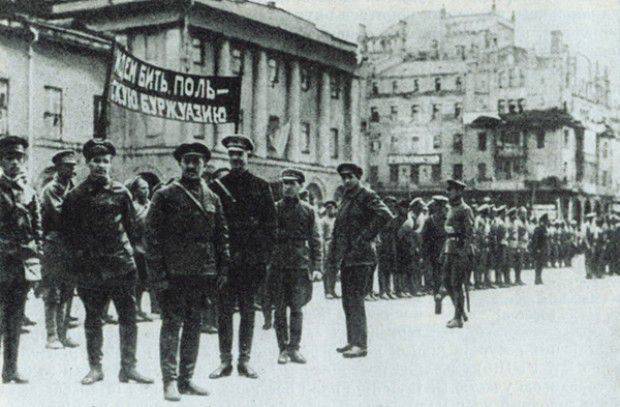 [/ Center]
[/ Center]History of the Soviet-Polish war against the background of fratricidal civil strife in Russia
The Soviet-Polish war of 1919 – 1920 was part of a large Civil War in the territory of the former Russian Empire. But on the other hand, this war was perceived by the Russian people - and those who fought for the Reds, and those who acted on the side of the whites - just like a war with an external opponent.
New Poland "from the sea to the sea"
This duality was created by history itself. Before the First World War, most of Poland was Russian territory, its other parts belonged to Germany and Austria - an independent Polish state did not exist for almost a century and a half. It is noteworthy that with the beginning of World War II, both the tsarist government and the Germans and the Austrians officially promised the Poles, after the victory, to re-establish an independent Polish monarchy. As a result, thousands of Poles in 1914 – 1918 fought on both sides of the front.
The political fate of Poland was predetermined by the fact that in 1915, under the pressure of the enemy, the Russian army was forced to retreat from the Vistula to the east. The whole Polish territory was under German control, and in November 1918 of the year, after the capitulation of Germany, power over Poland automatically passed to Jozef Pilsudski.
This Polish nationalist was engaged in anti-Russian struggle for a quarter of a century, with the beginning of the First World War, he formed the "Polish legions" - volunteer detachments as part of the troops of Austria-Hungary. After the capitulation of Germany and Austria, the "legionnaires" became the basis of the new Polish government, and Pilsudski officially received the title of "Head of State", that is, the dictator. At the same time, the new Poland led by the military dictator was supported by the victors in the First World War, first of all France and the USA.
Paris hoped to make Poland a counterweight to both defeated Germany, but not resigned, and Russia, in which the power of the Bolsheviks was incomprehensible and dangerous for Western European elites. The United States, for the first time realizing its increased power, saw in the new Poland a convenient excuse to extend its influence to the very center of Europe.
Taking advantage of this support and the general turmoil that engulfed the central countries of Europe after the end of the First World War, resurgent Poland immediately entered into conflict with all its neighbors over borders and territories. In the west, the Poles began armed conflicts with the Germans and the Czechs, the so-called "Silesian Uprising", and in the east with the Lithuanians, the Ukrainian population of Galicia (Western Ukraine) and Soviet Belarus.
For the new highly nationalistic Warsaw authorities, the troubled times of 1918 – 1919, when there were no stable authorities and states in the center of Europe, seemed very convenient to restore the boundaries of the ancient Polish-Lithuanian Commonwealth of the 16th – 17th centuries, from mor the sea and to the sea, that is, from the Baltic to the Black Sea coast.
The beginning of the Soviet-Polish war
Nobody declared the war of nationalist Poland against the Bolsheviks - in the conditions of widespread uprisings and political chaos, the Soviet-Polish conflict began without prior arrangement. Germany, which occupied Polish and Belarusian lands, capitulated in November 1918. A month later, Soviet troops moved into the territory of Belarus from the east, and Polish troops moved from the west.
In February 1919 in Minsk, the Bolsheviks proclaimed the creation of the “Lithuanian-Belarusian Soviet Socialist Republic,” and on the same days the first battles of Soviet and Polish troops began on these lands. Both sides tried to quickly correct in their favor chaotic folding borders.
The Poles were more fortunate then - by the summer of 1919, all the forces of Soviet power were diverted into war with the white armies of Denikin, who had begun a decisive offensive on the Don and in the Donbas. The Poles had by that time captured Vilnius, the western half of Belorussia and the whole of Galicia (that is, western Ukraine, where the Polish nationalists for six months had fiercely suppressed the uprising of the Ukrainian nationalists).
The Soviet government then several times offered Warsaw to formally sign a peace treaty on the terms of the actually formed border. It was extremely important for the Bolsheviks to free up all their forces to fight Denikin, who had already issued a “Moscow directive” —the order for the White’s general offensive against the old Russian capital.
[Center]
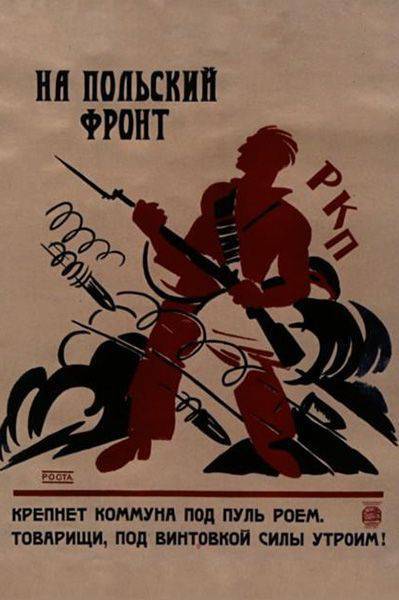
The Poles of Pilsudski did not respond to these peace proposals at the time - 70 of thousands of Polish soldiers equipped with the most modern arrived in Warsaw from France weapons. This army was formed by the French as early as 1917 from Polish immigrants and prisoners to fight the Germans. Now this army, very significant by the standards of the Russian Civil War, was useful to Warsaw to expand its borders to the east.
In August, the advancing white armies occupied the ancient Russian capital Kiev, 1919, and the advancing Poles invaded Minsk. Soviet Moscow was between two fires, and in those days it seemed to many that the days of the Bolshevik government were numbered. Indeed, in the case of joint actions of the White and the Poles, the defeat of the Soviet armies would be inevitable.
In September 1919, the Polish embassy arrived in Taganrog at the headquarters of General Denikin, which was met with great solemnity. The mission from Warsaw was led by General Alexander Karnitsky, the St. George Cavalier and the former Major General of the Russian Imperial Army.
Despite the solemn meeting and the mass of compliments that white leaders and representatives of Warsaw expressed to each other, the negotiations dragged on for many months. Denikin asked the Poles to continue the offensive against the Bolsheviks, General Karnitsky suggested, for a start, determine the future border between Poland and United Russia, which will be formed after the victory over the Bolsheviks.
Poles between red and white
While negotiations were underway with the Whites, the Polish troops stopped the offensive against the Reds. After all, the victory of white threatened the appetites of the Polish nationalists against the Russian lands. Pilsudski and Denikin supported and supplied Arms with the Entente (a union of France, Britain and the USA), and if the White Guards succeeded, it would be the Entente that would become the arbiter on the border between Poland and “white” Russia. And Pilsudski would have to make concessions - Paris, London and Washington, the victors in the First World War, becoming the masters of the destinies of Europe at that time, had already determined the so-called Curzon line, the future border between the restored Poland and the Russian territories. Lord Curzon, the head of the Foreign Office of Great Britain, led this line along the ethnic border between Catholic Poles, Galicians-Uniates and Belarus-Orthodox.
Pilsudski understood that if White captured Moscow and held negotiations under the patronage of the Entente, he would have to cede part of the captured lands in Belarus and Ukraine to Denikin. The Bolsheviks for the Entente were outcasts. Polish nationalist Pilsudski decided to wait for the Red Russians to reject the White Russians to the outskirts (so that the White Guards would lose their influence and no longer compete with the Poles in the eyes of the Entente), and then start a war against the Bolsheviks with the full support of the leading Western states. This option promised the Polish nationalists maximum bonuses in case of victory - the seizure of vast Russian territories, up to the restoration of the Polish-Lithuanian Commonwealth from the Baltic to the Black Sea!
While former Tsarist generals Denikin and Karnitsky were wasting time on polite and fruitless talks in Taganrog, on November 3 on November 1919, a secret meeting of representatives of Pilsudski and Soviet Moscow took place. The Bolsheviks were able to find the right person for these negotiations - the Polish revolutionary Julian Markhlevsky, who had known Pilsudski since the time of the anti-royal 1905 uprisings of the year.
At the insistence of the Polish side, no written agreements were concluded with the Bolsheviks, but Pilsudski agreed to stop the advance of his armies to the east. Secrecy became the main condition of this oral treaty between the two states - the fact of the agreement between Warsaw and the Bolsheviks was carefully concealed from Denikin, and mainly from England, France and the United States, who provided political and military support to Poland.
Polish troops continued local battles and gunfights with the Bolsheviks, but the main forces of Pilsudski remained immovable. The Soviet-Polish war stopped for several months. The Bolsheviks, knowing that in the near future we could not be afraid of the Polish attack on Smolensk, almost all of their forces and reserves were transferred against Denikin. By December 1919, the White armies were routed by the Reds, and the Polish embassy of General Karnitsky left General Denikin’s headquarters. On the territory of Ukraine, the Poles took advantage of the retreat of the white troops and occupied a number of cities.
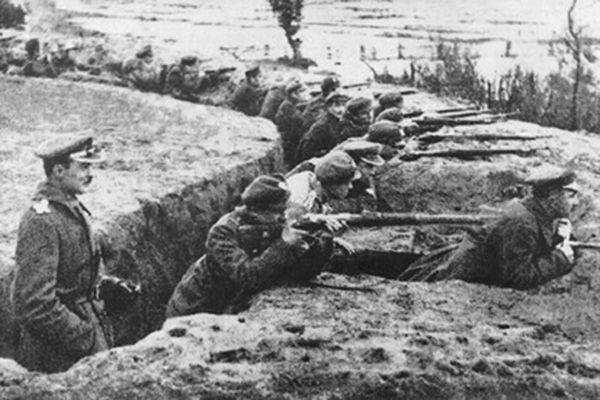
It was Poland’s position that predetermined the White’s strategic defeat in the Russian Civil War. One of the best Red commanders of those years, Tukhachevsky, directly admitted this: “Denikin’s attack on Moscow, supported by the Polish offensive from the west, could have ended much worse for us, and it’s difficult to even predict the final results ...”.
Pilsudski offensive
Both the Bolsheviks and the Poles understood that the informal truce in the fall of 1919 was a temporary phenomenon. After the defeat of Denikin's troops, it was Pilsudski that became for the Entente the main and only force capable of withstanding the “red Moscow” in Eastern Europe. The Polish dictator skillfully took advantage of this circumstance, bargaining for major military assistance from the West.
In the spring of 1920, only one France supplied Poland 1494 guns, 2800 machine guns, 385 thousand rifles, about 700 aircraft, 200 armored vehicles, 576 million rounds of ammunition and 10 million shells. At the same time, many thousands of machine guns, over 200 armored vehicles and tanks, more than 300 aircraft, 3 million sets of uniforms, 4 million pairs of soldier's shoes, a large number of medicines, field communications equipment and other military equipment, American steamers delivered to Poland from the United States.
By April 1920, Polish troops on the borders with Soviet Russia consisted of six separate armies, fully equipped and well-armed. The Poles had a particularly serious advantage in the number of machine guns and artillery, and aviation and the armored vehicles of the Pilsudski army surpassed the Reds absolutely.
After waiting for the final defeat of Denikin and thus becoming the main ally of the Entente in Eastern Europe, Pilsudski decided to continue the Soviet-Polish war. Relying on the weapons generously supplied by the West, he hoped to quickly defeat the main forces of the Red Army, weakened by long battles with the whites, and force Moscow to cede all lands of Ukraine and Belarus to Poland. Since the defeated whites were no longer a serious political force, Pilsudski had no doubt that the Entente would prefer to give these huge Russian territories under the control of the allied Warsaw, rather than seeing them under the rule of the Bolsheviks.
17 April 1920, the Polish "Head of State" approved a plan to seize Kiev. And on April 25, Pilsudski’s troops launched a general offensive on Soviet territory.
This time, the Poles did not delay the negotiations and quickly concluded a military-political alliance against the Bolsheviks with both the white and Ukrainian nationalists of Petliura who remained in the Crimea. Indeed, in the new conditions of 1920, Warsaw was the main force in such alliances.
The head of the Whites in Crimea, General Wrangel, stated bluntly that Poland now has the most powerful army in Eastern Europe (at that time 740 of thousands of soldiers) and it is necessary to create a “Slavic front” against the Bolsheviks. The official representation of the White Crimea opened in Warsaw, and the so-called 3 Russian Army (the first two armies were located in the Crimea) began to form on the territory of Poland itself, which was created by former revolutionary terrorist terrorist Boris Savinkov, familiar with Pilsudski through the pre-revolutionary underground.
The fighting was conducted on a huge front from the Baltic to Romania. The main forces of the Red Army were still in the North Caucasus and Siberia, where they finished off the remnants of the white armies. The rear of the Soviet troops was also weakened by peasant uprisings against the policy of "war communism."
7 May 1920, the Poles occupied Kiev - it was already the 17-I change of power in the city over the past three years. The first strike of the Poles was successful; they captured tens of thousands of Red Army soldiers and created an extensive foothold on the left bank of the Dnieper for further offensive.
Counterattack Tukhachevsky
But the Soviet government was able to quickly transfer reserves to the Polish front. At the same time, the Bolsheviks skillfully used patriotic sentiments in Russian society. If the defeated whites went to a forced alliance with Pilsudski, then broad strata of the Russian population perceived the Polish invasion and the seizure of Kiev as external aggression.
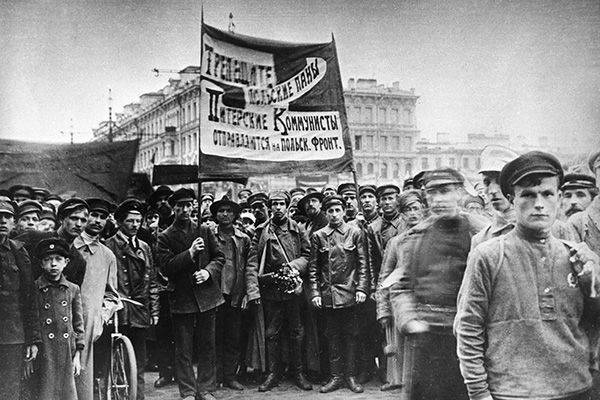
These national sentiments were reflected in the famous appeal of the hero of the First World War, General Brusilov, “To all former officers, no matter where they are,” which appeared on May 30 on May 1920. Far from sympathizing with the Bolsheviks, Brusilov declared to the whole of Russia: “As long as the Red Army does not allow the Poles into Russia, I and the Bolsheviks are on the way.”
2 June 1920, the Soviet government issued a decree "On the release from the responsibility of all the White Guard officers who will help in the war with Poland." As a result, thousands of Russian people volunteers joined the Red Army and went to fight on the Polish front.
The Soviet government was able to quickly transfer reserves to Ukraine and Belarus. In the Kiev sector, the cavalry army of Budyonny became the main striking force of the counterattack, and in Belarus against the Poles, the divisions, liberated after the defeat of the white troops of Kolchak and Yudenich, went into battle.
At Pilsudski’s headquarters, they did not expect that the Bolsheviks would be able to concentrate their troops so quickly. Therefore, despite the superiority of the enemy in technology, the Red Army in June 1920 re-occupied Kiev, in July - Minsk and Vilnius. The Soviet offensive contributed to the uprising of the Belarusians in the Polish rear.
Pilsudski’s troops were on the verge of defeat, which worried the Western patrons of Warsaw. First, a note was issued by the British Foreign Office with a proposal for an armistice, then the Polish ministers themselves turned to Moscow with a request for peace.
But here the sense of proportion changed the Bolshevik leaders. The success of the counteroffensive against Polish aggression gave rise to the hope of proletarian uprisings in Europe and the victory of the world revolution among them. Lev Trotsky then directly proposed "probing the revolutionary situation in Europe with the Red Army bayonet."
Despite losses and devastation in the rear, the Soviet forces continued their decisive offensive, striving to take Lvov and Warsaw in August 1920. The situation in the west of Europe was then extremely difficult, after the devastating world war, all states, without exception, shook the revolutionary uprisings. In Germany and Hungary, local communists then quite realistically claimed power, and the emergence of the victorious Red Army of Lenin and Trotsky in the center of Europe could really change the whole geopolitical alignment.
As Mikhail Tukhachevsky, who commanded the Soviet offensive on Warsaw, later wrote: "There is no doubt that if we were victorious on the Vistula, the revolution would have covered the entire European continent with a fiery flame."
"Miracle on the Vistula"
In anticipation of the victory, the Bolsheviks had already created their Polish government - the Provisional Revolutionary Committee of Poland, headed by the communist Poles Felix Dzerzhinsky and Julian Marchlewski (who had negotiated with Pilsudski about the truce at the end of 1919). The famous cartoonist Boris Efimov has already prepared for the Soviet newspapers a poster entitled “Red Heroes Taken Warsaw”.
Meanwhile, the West strengthened its military support to Poland. The actual commander of the Polish army was the French General Weigan, head of the Anglo-French military mission in Warsaw. Several hundred French officers with great experience of world war became advisers in the Polish army, creating, in particular, a radio intelligence service, which by August 1920 had established interception and decryption of Soviet radio communications.
On the side of the Poles, the American air squadron was actively fighting, funded and manned by pilots from the United States. In the summer of 1920, the Americans successfully bombed the oncoming Budyonny cavalry.
The Soviet troops, who had reached Warsaw and Lviv, despite the successful offensive, found themselves in an extremely difficult situation. They are hundreds of kilometers away from the supply bases, because of the devastation in the rear they could not deliver the replenishment and supply in time. On the eve of the decisive battles for the Polish capital, many red regiments were reduced to 150 – 200 fighters, artillery lacked ammunition, and a few working aircraft could not provide reliable reconnaissance and detect the concentration of Polish reserves.
But the Soviet command underestimated not only the purely military problems of the “march to the Vistula”, but also the national sentiments of the Poles. As in Russia, during the Polish invasion, a surge in Russian patriotism arose, and in Poland, when the Red forces reached Warsaw, a national upswing began. This was facilitated by active Russophobic propaganda, which represented the advancing Red forces in the form of Asian barbarians (although the Poles themselves in that war were extremely far from humanism).
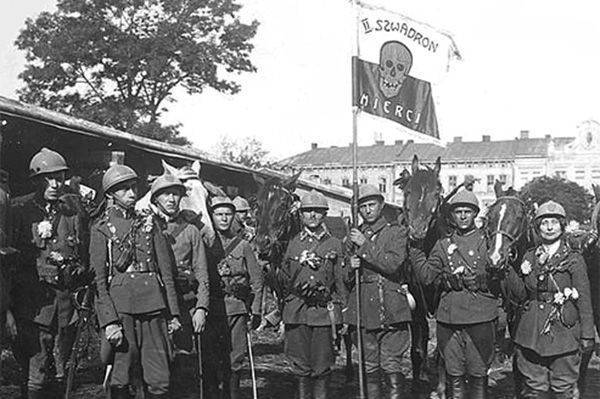
The result of all these reasons was the successful Polish counter-offensive launched in the second half of August 1920. In the Polish history, these events are called unusually pompous - “Miracle on the Vistula”. Indeed, this is the only big victory of the Polish weapon over the past 300 years.
Peace Peace of Riga
The actions of the White forces of Wrangel contributed to the weakening of the Soviet troops near Warsaw. In the summer of 1920, White just launched his last offensive from the territory of Crimea, capturing the vast territory between the Dnieper and the Sea of Azov and diverting the red reserves to himself. Then the Bolsheviks, in order to free up part of the forces and protect the rear from peasant uprisings, even had to make an alliance with the anarchists of Nestor Makhno.
If in the autumn of 1919, Pilsudski’s policy predetermined the defeat of whites in the attack on Moscow, in the summer of 1920, it was Wrangel’s blow that predetermined the defeat of the Reds in the attack on the Polish capital. As the former tsarist general and military theorist Svechin wrote: “In the end, the Warsaw operation was won not by Pilsudski, but by Wrangel.”
The Soviet troops, crushed near Warsaw, were partially captured, and partly retreated into the German territory of East Prussia. Only near Warsaw, 60 of thousands of Russians found themselves in captivity, in total, over 100 thousands of people were imprisoned in Polish prisoner of war camps. Of these, at least 70 thousands died in less than a year - this vividly characterizes the monstrous regime that the Polish authorities established for the captives, anticipating the nazi concentration camps.
The fighting continued until October 1920. If over the summer, the red troops fought westward over 600 km, then in August-September, the front again rolled back more than 300 km to the east. The Bolsheviks could still gather new forces against the Poles, but chose not to take risks — they were increasingly distracted by peasant uprisings that had spread throughout the country.
Pilsudski, after a costly success near Warsaw, also did not have sufficient forces for a new offensive on Minsk and Kiev. Therefore, peace negotiations began in Riga, stopping the Soviet-Polish war. The final peace treaty was signed only on 19 March 1921 of the year. Initially, the Poles demanded monetary compensation in 300 million royal gold rubles from Soviet Russia, but during the negotiations they had to cut their appetites exactly 10 times.
As a result of the war, neither Moscow nor Warsaw’s plans were implemented. The Bolsheviks failed to create Soviet Poland, and the nationalists of Pilsudski could not recreate the ancient borders of the Commonwealth, which included all Belarusian and Ukrainian lands (the most zealous supporters of Pilsudski insisted even on the "return" of Smolensk). However, the Poles for a long time returned to their power the western lands of Ukraine and Belarus. Until 1939, the Soviet-Polish border was only 30 km west of Minsk and was never peaceful.
In fact, the Soviet-Polish war of the 1920 of the year laid in many ways the problems that “fired” in September of the 1939 of the year, contributing to the start of the Second World War.
Information